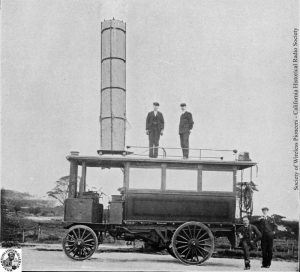Global Cities at the Tate Modern in London. It’s a pocket version of an exhibition that was running last year at the Arsenale during Venice Architecture Biennale. Cities, architecture and society, curated by Richard Burdett, focused on the key factors facing large scale metropolitan areas around the world. Last year, some critics were unhappy with the show, saying that there were too many facts and figures and not enough architecture. I guess some might find that the Tate version of it lacks to much of a fine art aura. Whatever… i found the show engrossing.
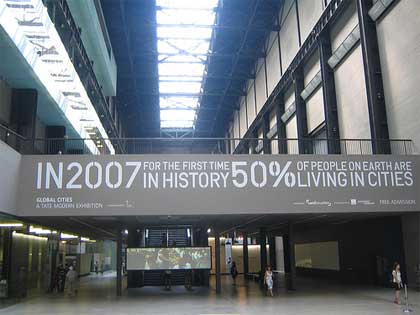
The starting point is the fact that today more than half of the world’s population lives in cities. “The 21st century will be the first truly urban era, in which more than 75% of the world’s population will live in urban areas, much of it in mega-cities with more than 20 million inhabitants concentrated in the countries undergoing rapid development in Asia, Africa and South America. In the meantime, many Western and European cities are shrinking, or have been forced to re-invent themselves in order to adapt to a post-industrial condition.”
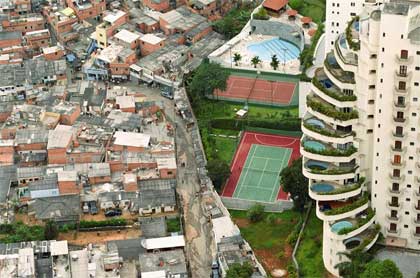 Saõ Paulo: an apartment building for the wealthy overlooks a favela, ironically called Paraisópolis (Paradise city). Photo: Luiz Arthur Leirão Vieira (bigger caption)
Saõ Paulo: an apartment building for the wealthy overlooks a favela, ironically called Paraisópolis (Paradise city). Photo: Luiz Arthur Leirão Vieira (bigger caption)
The Turbine Hall which hosts the Global Cities exhibition is big but not quite as much as Venice’s 300-metre long Corderie dell’Arsenale. That’s probably one of the reasons why the London version is tinier, there’s more focus on London obviously, less photographs by artists who portray urban sprawl, the London team also skipped a few cities –namely Barcelona, Berlin, Bogota, Caracas, Milan-Torino and New York– which in some cases made perfect sense (who’d say that Milan and Turin provide the most exciting examples of urban life?) But if the London gig is not enough for you, there’s still plenty of paper fun in the catalogues of the Venice Architecture Biennale (Amazon USA

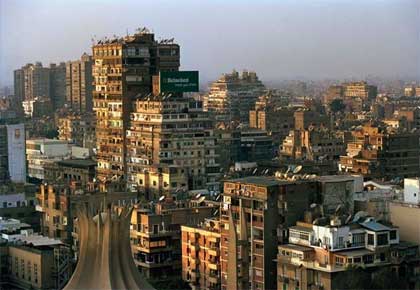 View from the balcony apartment on the island Gezira over Zamalek, Cairo, by Heiner H. Schmitt Jr.
View from the balcony apartment on the island Gezira over Zamalek, Cairo, by Heiner H. Schmitt Jr.
So we’re left with Cairo, Istanbul, Johannesburg, London, Los Angeles, Mexico City, Mumbai, São Paulo, Shanghai and Tokyo. Information and data are painted on the walls to demonstrate on these cities are being transformed in social, economic and cultural terms. Besides, each city is studied through five thematic lenses – speed, size, density, diversity and form.
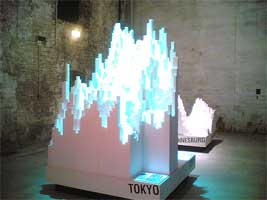
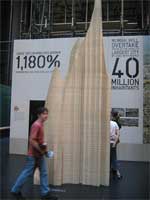
Venice has polystyrene 3D graphic presentations to represent the density of the cities, London had wooden ones. The models compare the number of people living within the administrative boundaries of the cities, the highest the peak, the higher the density.
The Tate website is very informative and clear. I’m not going to repeat what’s already there. Instead i’ll just present and link to some of the photographers whose work is on show at the Tate for the way they engage in a sometimes spectacular way (for its beauty or creepiness) with urban phenomena.
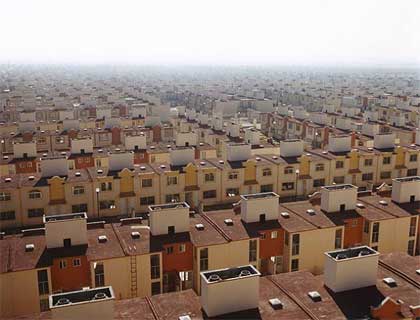 Scott Peterman‘s Mexico City Ecataepec, 2006 (bigger)
Scott Peterman‘s Mexico City Ecataepec, 2006 (bigger)
There’s quite a few images so the show proceeds over here!


